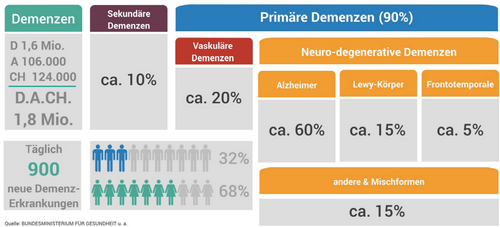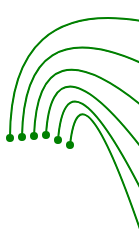Worldwide, one person falls ill with dementia every three seconds. As a result of the ageing of society, the number of dementia patients in Germany will double from the current 1.5 million to approximately 3 million in 20501, with statutory health insurance companies already spending over €5.6 billion on the treatment of dementia. In almost two thirds of cases, this is Alzheimer's dementia (see Figure 1).

The currently difficult care situation of dementia patients will be exacerbated, as there will be a shortage of approx. 500,000 urgently needed care workers in Germany by 2030 ("care emergency", see TK's 2018 innovation report3,4). Since several pharmaceutical companies have discontinued extensive studies on the drug treatment of Alzheimer's dementia, a cure is currently not foreseeable. Early detection of Alzheimer's dementia (AD) is therefore crucial in order to
-
slow down the course of cognitive degradation that the patient suffers
-
patient and relatives can plan the future and identify and guarantee external help
-
and the patient can lead a dignified, self-determined life as far as possible (see also the comments of Richard Taylor, psychologist and AD patient5,6,7
For dementia diseases, a differential diagnosis of high quality is essential to exclude diseases whose symptoms are similar to those of AD. Such a distinction is of decisive importance with regard to the life planning of the affected persons and can prevent mistreatment.
A diagnosis as early as possible therefore helps to raise the curve of cognitive degradation of patients in old age and to mitigate the course of dementia.
The new concept of human-technology interaction presented in this project offers a promising potential for the hitherto inadequate early detection and differential diagnosis of AD. The innovative idea of this project is to create a system for improved early detection of AD using AI-based evaluation of EEG time series (electroencephalography) in combination with an intelligent emotional-empathetic digital assistant (IEEDA) for physician and patient.
- ↑ Berlin-Institut für Bevölkerung und Entwicklung: „Demenz-Report“ (2011)
- ↑ H. Doymeyer, „Info-Grafik Demenz 2016“, https://denken.de/infografik-demenz-2016
- ↑ Techniker Krankenkasse Innovationsreport 2018, PDF S. 292-313, https://www.tk.de/tk/mobil/aerzte/innovationsreport/521220
- ↑ K. Glied, „Roboter in der Sozialbranche“, Medizin & Elektronik (2018), https://www.medizin-und-elektronik.de/medizin-40-iot/artikel/153355/
- ↑ R. Taylor, Psychologe, Alzheimer-Patient, gest. 2015: „Ich bin derjenige, der hier stirbt“, FR vom 15.5.2011, https://www.bgt-ev.de/fileadmin/Mediendatenbank/Logbuch/Alzheimer__Ich_bin_hier_derjenige_der_stirbt.pdf
- ↑ R. Taylor, „Alzheimer und Ich“, 3. Auflage, (2011), Verlag Hans Huber
- ↑ R. Taylor, „Hallo Mister Alzheimer”, (2013), Verlag Hans Huber


 English
English  Deutsch
Deutsch